Member Contributions
Coming Home
by Richard Arnold
We were the last two. The last two officers of the artillery battalion that landed 12 months earlier at Qui Nhon with the 1st Cavalry Division. My friend Jack Woods and I had graduated from Officer Candidate School together, served at Ft. Benning together for 18 months and then a year in Vietnam.
As battery executive officers, we had been held over to allow our, just in country, battery commanders to get their feet on the ground. Now we had permission to leave country. We grabbed our duffel bags and commandeered a jeep and driver to take us to the airfield at Camp Evans. We had already sent most of what we were taking home in a footlocker to Ft. Bragg our next assignment.
It was easy to catch a hop on a C-130 headed for Saigon. We landed at Tan Son Nhut and immediately went looking to get on a manifest home.

We found the Air Force Sergeant Major, (He had a hell of a lot of stripes) in charge and asked if we could please go home. He said to check in every morning at 8AM and he would try and get us out in the next few days.
We looked at each other and said, Oh S___! Another three days in country. To console ourselves we changed into civilian clothes and went into town. We had dinner at the Rex. The Rex was officer’s quarters, but you had to be a Bird-Colonel to get a room. However, they had a great officer’s club and restaurant. We ate on the patio. You could watch the night rocket and artillery fire in the outskirts of Saigon from there. And at the same time enjoy a steak with a great French wine.
After a wild race through Saigon’s winding streets on motorized rickshaws, we arrived at our hotel. Safe and cheap, it was near the airport.
We ran to the latrine grabbed our uniforms out of our duffle bags. Not pressed, no starch but, still the proper uniform. We even had insignia we purchased from the little old Vietnamese women outside the base. So we changed for the third time and headed for our “freedom bird”.
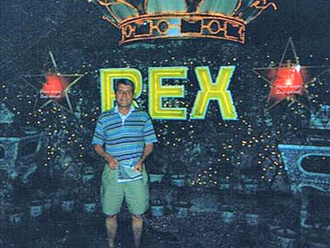
In less than fifteen minutes we had dropped our bags at the hold and were boarding the World Airways flight. My jaw dropped as I was greeted by the stewardess. The stewardess was a real, live, good looking, American woman. What a great idea! So, we settled in for the 14 hour plane ride to Travis AFB California. As settled as you could get in the smallest airline seat ever made. They had good meals on the flight, but no alcohol. A lot of guys played cards or checkers to pass the time.
We arrived at Travis in the middle of the morning. During our in-processing we were told we could not leave the base in uniform. The PX was open if we needed to purchase civilian clothes. So we quickly changed for the fourth time and headed for San Francisco and the airport and home.
A Vets Thoughts on “Retirement”
by John MacBride
A veteran leaves the 'job' and retires to a better life, many are jealous, some are pleased, and others, who may have already retired, wonder if he knows what he is leaving behind, because we already know.
1. We know, for example, that after a lifetime of camaraderie, that few experience, it will remain as a longing for those past times.
2. We know in the Military life, that there is a fellowship which lasts long after the uniforms are hung up in the back of the closet.
3. We know that, even if he throws them away, they will be on him with every step and breath that remains in his life.
We also know how the very bearing of the man speaks of what he was and in his heart, still is. These are the burdens of the job.
You will still look at people suspiciously, still see what others do not see, or choose to ignore and always will look at the rest of the Military world with a respect for what they do; only grown in a lifetime of knowing. Never think for one moment you are escaping from that life. You are only escaping the 'job' and merely being allowed to leave 'active' duty. So what I wish for you is that whenever you ease into retirement, in your heart you never forget for one moment that you are still a member of the greatest fraternity the world has ever known!
From one Veteran to another, it's an honor to be in your company. Thank you for your service to our country and defending the freedoms we enjoy.
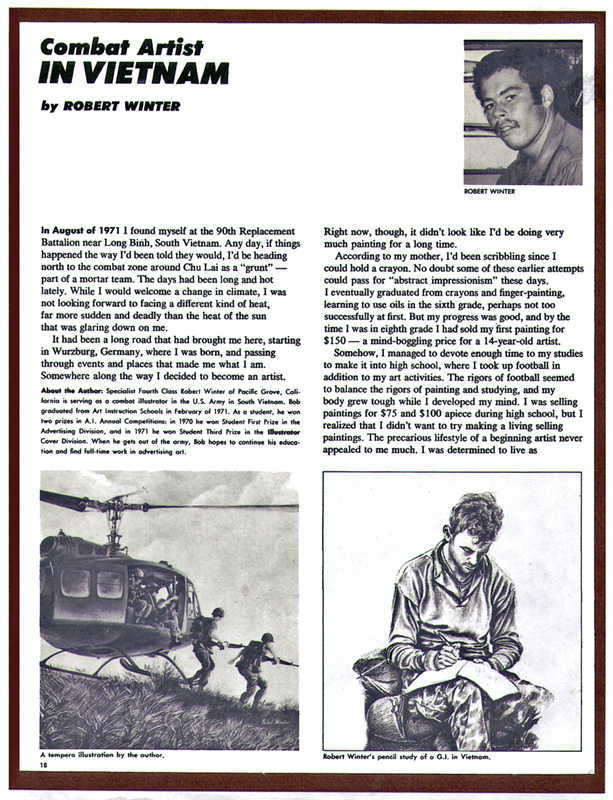
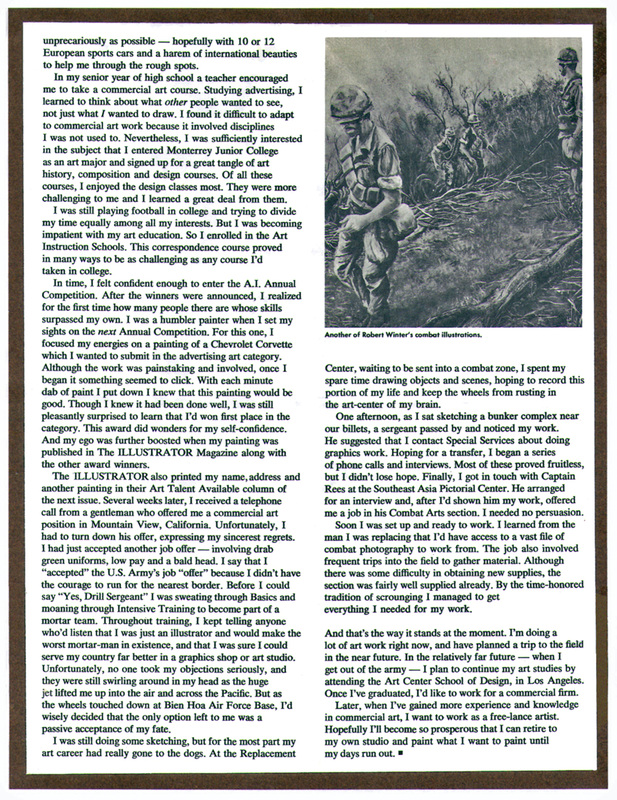
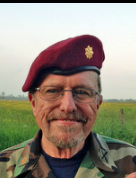
Why I am going to Normandy
For the 70th Anniversary of D Day
My name is Richard L. "Rick" Arnold. I am a proud Vietnam Veteran. My wife, Geneva, and I have been happily married for 33 years. We live in Carson City, Nevada.
WWII: Two of my uncles served in WWII. One was in the Army Air Corps; the other was a Tanker in North Africa and Europe. My uncle Len, the tanker, told me a few combat stories when I was young. He could see I had a real interest in the military. I remember a picture taken when I was just eight or nine, wearing my uncle’s overseas cap and holding his M1 rifle. Even at that age I entertained thoughts of being a paratrooper. Shortly after my seventeenth birthday, I enlisted in the Army and after basic and secondary training arrived at Ft. Campbell, KY in October of 1958 for airborne training. Most of the NCO’s were WWII and Korean War veterans, many with combat jump stars on their wings. They were great role models. Unfortunately my admiration was lessened when I was refused service at my local VFW post. They said I had not been in a real war.
Paratrooper: My memory of that first jump is a vivid today as it was then. Geneva once asked me why I still want to jump out of airplanes at the age of 73. My answer was I still remember the wonderful feeling of power and exhilaration I felt at 17. Most of my army career was spent on jump status. Two of my deployments were with airborne units on jump status. My first deployment was as a member of the 3rd Bde. (Abn) of the 1st Cav. Division. My second was as a member of the 3rd Bde combat team of the 82nd Airborne Division, deployed during TET 1968.
As a member of the 1st Cav. Division my artillery battery fired in support of the 1/7 Infantry Bn. during the Battle of Ia Drang. This battle was retold in the movie “We were Soldiers”. My final tour was an advisor to a South Vietnamese infantry battalion. I proudly wear the combat infantryman’s badge awarded for that tour. My combat awards include the Silver Star, three Bronze Stars, one with v, and the air medal.
A couple of years ago, while making a jump in Uruguay, a member told me about the Liberty Jump Team and their jumps in Normandy. I applied for membership and after completing their jump course joined the team in time to jump in Normandy last year. This coming June I will have the honor of participating, with team members, in Ceremonies commemorating the 70th anniversary of the Normandy invasion. The team will make several jumps from Whiskey 7, a C47 aircraft used to drop troops on D Day. W7 is being flown from NY to France to participate in the event. The drop zones will be the same used by 101st Airborne and 82nd Airborne Divisions on that fateful night.
Note: Rick Arnold served four years (2010-2014) as President of the Carson Area Chapter-388
Don Bemis, RM3, USN
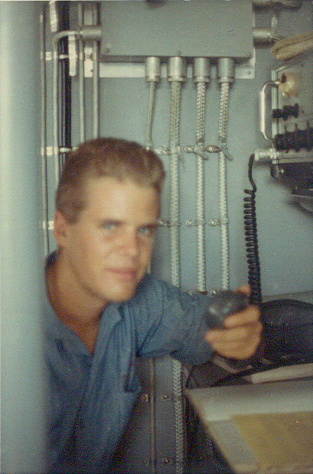
I arrived April 14, 1966 at the Naval Amphibious Base, Coronado, California for Swiftboat training. Our crew of 6, 1 officer, and 5 enlisted men underwent the training to prepare for our duties. I was the radioman and my duties were, all communications, operating the radar, piloting the boat. But I also had to be cross trained in gunnery, and engine service. The entire crew had to be cross trained. I spent 2 weeks at Camp Pendleton for all weapons training, underwent 1 week of SERE training at Whidbey Island in Washington State. We sailed our boats to San Clemente Island off the San Diego coast for close in weapons firing training. I also went through an extensive Vietnamese language training course for the entire 4 months at Coronado.
After our training, and a short leave, we got ready to fly to our duty station in Vietnam. Our crew, along with a couple other crews, assembled at Travis AFB, and boarded our transport plane. Of course, we were hoping for a nice, fast comfy jet, but we boarded a C-121 Mats transport plane. This is the military variation of a Constellation airliner. No jets, just propellers. There were no soft seats, just canvas seats along each side of the fuselage. Most of the time, we traded places sleeping on the pile of duffle bags piled in the center of the cargo area. We headed West taking 4 days, landing for fuel stops in Hawaii, Midway, Wake, Guam, then Saigon’s Tan Son Nhut. We then were transported to Cam Ranh Bay Navy Base, where we were assigned to PCF Division 104, later changed to Coastal Squadron 14.
The base was under construction, so we only had tents, salt water showers, and a small mess building for a couple of months until the barracks were finished. Once finished, our quarters were very comfortable. Thank you Seabees. We always ate very well on the base, and while patrolling, we also ate good.
The Swift Boat was 50 feet in length, with a beam of 13 feet, constructed of aluminum, with NO armor plating. Twin 12V71 Detroit Diesel Engines powered the boat at 25 knots, 32 knots in an emergency. For weapons, we carried twin 50 cal. machine guns atop the pilot house, a single 50 cal. mounted on top of an 81 mm mortar at the after end of the boat. The mortar was capable of firing HE rounds, WP rounds, Proximity rounds, and Illumination rounds. Each crew member was issued an AR15, 38 cal. Pistol, and we each also carried a knife. The boat also had on hand, M79 grenade launchers, and 12 gauge semi-automatic shot guns.
There were 9 different patrol areas that we patrolled, starting North of Nha Trang, to Phan Rang to the South. Some of the areas we had to patrol took at least 2 hours to reach, so our patrols were actually longer than the 24 hours duration. We were on duty for 24 hours on and 24 off, for 2 weeks, then had 1 week off. During our week off, we made 1, 12 hour patrol checking the harbor entrance for anything unusual. I made a total of 116 patrols. We had a total of 15 boats at our base, and I made patrols on all but 2 of them. One note of irony regarding the boat I made 46 patrols on, PCF-80. It was transferred to Chu Lai, July 1967 where it was, later on, instrumental in rescuing the crew of PCF-76 which had capsized in heavy seas.
Our patrol duties were to board and search fishing boats, sampans, junks, and cargo vessels where I would interview the Vietnamese on board, check for proper identification, licenses, paperwork or manifests of cargo loaded aboard, and to search for any contraband. We found a lot of weapons hidden in some of the vessels. If we found any unauthorized weapons, we usually took the people into custody and tossed the weapons overboard. If the vessel was too large for us to tow to base, we called for an (MSO) Navy Mine Sweeper vessel to deal with the larger Vietnamese vessel. If the weapons were found in smaller fishing boats, sometimes we just sank the boats, and took the people back to base.
During one patrol, we took some Army personnel, transferred to small outboard skiffs, to the beach at Hon Heo Peninsula. We waited in the dark on the beach for them to return to the skiffs. We were never told the reason for this operation, but the waiting in the dark on the beach for several hours for the solders to return was unnerving.
Several times during patrols, we moved closer in to shore to provide some fire support for some operation going on. A few times, there were large Navy ships also providing fire support at the same time. Hearing 5 inch and 8 inch shells passing overhead is something to hear. Glad that we were not on the receiving end. More than once, we did see tracer rounds coming our direction, fortunately, we were usually far enough off shore that we were out of range.
Sometimes we carried a Vietnamese Naval officer as liaison. During one of these joint patrols, the Vietnamese officer wanted to do some fishing so we could have some fresh fish for lunch. To our amazement and total surprise, the officer took a concussion grenade, pulled the pin, held it for a couple of seconds, then tossed it into the water. After the explosion, stunned fish came to the surface, which we just picked up. We all thought, “What a NUT”!! But what a lunch!
We did a lot of swimming at Cam Ranh Bay on our off duty time, where we had a very beautiful beach.
After a year of patrolling, and fortunately, not a single fatality at the base during my time there, it was time to go home. Believe it or not, I did request to return to Cam Ranh Bay for a second tour after my 30 day leave, but was denied. My duty in country was a very good experience for me, and the only times I was really scared was when we were on patrol in very rough seas. Being on a 50 foot boat, tossed around in very rough seas with 10 foot plus swells that sometimes broke very close aboard, is quite an experience.
Our trip home was in comfort aboard a Continental Airlines 707 with stewardesses aboard. WOW women!! And most welcome of all, Whole Milk! Which us very thirsty for “real milk” passengers, drank it all within ½ an hour. We departed from the Air Force Base at Cam Ranh Bay, flying into Japan for a fuel stop, then heading to San Francisco, and home.
For my second trip to Vietnam, in March of 1968, I was assigned to Assault Craft Unit One. For training again at Coronado Amphibious Base, Coronado, Calif. After training there, I was transferred to the Philippines for additional landing craft training, then was flown to Da Nang for duty aboard LCU-1539, hauling ammunition up the Da Nang river. However, after only 2 days of being in country, my orders were modified to proceed to White Beach Naval Base Okinawa, for duty aboard LCU-1616 for the remainder of my enlistment. My duty aboard was serving as the radioman. We transported ammunition and other supplies from cargo ships anchored off shore, to the base.
I was discharged on Friday, October 25th, 1968, 2 days before my 21st birthday. As per my contract with the Navy, joining at age 17, I was to serve until I was 21. It just so happened that in 1968, my birthday was on a Sunday.
Bonds of battle last for a lifetime
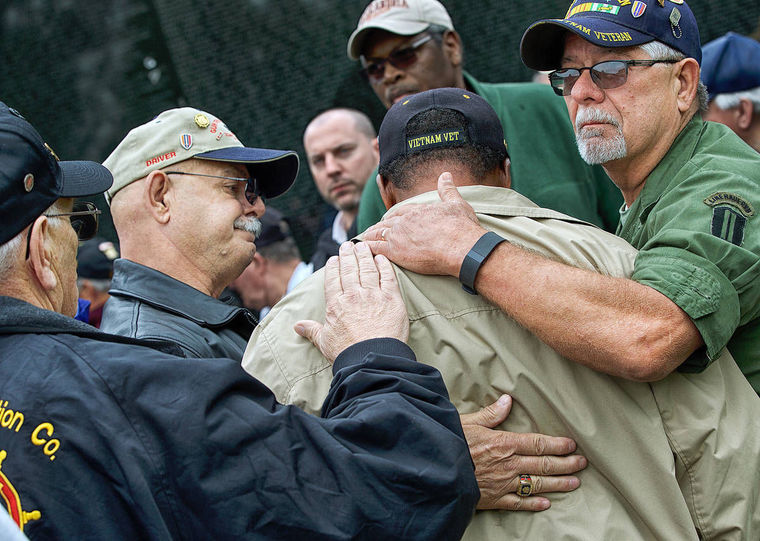
PHOTO BY DAVE ELLIS THE FREE LANCE-STAR
(Article supplied by VVA 388 member - Tom Spencer who, himself was a member of the 359th Transportation Company and served with them in Vietnam.)
BY KRISTIN DAVIS/THE FREE LANCE-STAR
They slowly descended the slick black stones of the Vietnam Veterans Memorial, a small tide of graying soldiers in 359th Transportation Company caps and shirts that left no question.
This was their wall.
Michael Buirge had come here once before.
“There are so many names on this wall. I forgot,” he said.
Then, turning to platoon leader Burrell Welton, his voice broke. “I didn’t do anything special.”
Welton nodded his head, threw an arm around Buirge’s shoulder.
Neither said anything else. Decades of shared experiences — nightmares and anxiety they couldn’t quite place, guilt and excesses that staved off what they didn’t want to remember — spoke their own silent language.
They’d arrived in Fredericksburg a day before from as far away as California for a reunion marking the 50th anniversary of the reactivation of the 359th. A tour bus had brought the group of 30 veterans to Washington on Wednesday, dropping them off in view of the Vietnam Memorial.
“We need to find Andy’s,” Bob Dye said.
Spc. George D. “Andy” Anderson had been one of them, an Ohioan barely out of his teens when his country called.
Like Buirge and Dye and Welton, he’d come to Vietnam in 1967 as a replacement for the 359th, a status that bonded them from the start.
Anderson had been mortally wounded in an ambush 75 days before he was set to go home.
Someone called out where to find it: Panel 35E, Row 28.
Welton headed toward the center of the V, where the wall rose higher. He pointed to a single name among more than 58,000 chiseled in shining stone.
“Right there. Right there,” he said.
Welton put his hands in his pockets, shook his head. He looked at the ground and, having found what he’d come to see, walked away.
A PROMISE—AND ANGUISH
Welton felt responsible.
Almost half a century later, feelings of failure still welled up. He was Anderson’s platoon leader. It was his job, he said, to make sure he got home safe.
“I didn’t hold my promise to him.”
A day after their visit to the wall, Welton, who’d come from Colorado, sat in a banquet room of the Fredericksburg Hospitality House Hotel and Conference Center where the following morning the 359th Transportation Company Association would elect officers and vote on whether to have a reunion once a year instead of every two years.
They’d spent the day visiting the U.S. Army Transportation Museum at Joint Base Langley–Eustis in Newport News, one of a flurry of activities packed into the veterans’ four-day visit to Virginia. After the Vietnam Memorial, they’d visited Arlington National Cemetery and placed a wreath at the Tomb of the Unknown Soldier.
They’d ended the day with a military pageant called “Twilight Tattoo” that told the history of the Army through musicians and drill teams.
“The ‘Tattoo’ is a lively and entertaining way to end the long and perhaps difficult trip down memory lane,” a reunion schedule stated, and Buirge and Dye and Welton agreed that it had.
But on Thursday night, the trio sat together at the Central Park hotel and thought about the wall, about Anderson, about the 13 other men from their company whose names were there, about the hundreds—maybe thousands—of others who’d died service-related deaths after the war.
They have spent most of their lives trying to reconcile their survival.
“It was just sheer freaking luck,” Buirge had said as he stood at the wall.
Most had ended up in Vietnam the same way. They were sons and nephews of World War II veterans who’d grown up hearing stories of heroics across Europe and the Pacific.
The 359th, in which they all ended up, had been first activated in December 1942; its trucks had rolled across France, Belgium and Germany. The company was reactivated in 1966 as America’s involvement in the war in Southeast Asia intensified.
Dye and Buirge were drafted.
“My turn,” Dye thought when his number was called.
Welton enlisted at 18 after flunking his first semester of college. By 19, he was a highly respected officer volunteering to lead more than his share of convoys along Mang Yang Pass.
Every morning, some 60 tankers, each hauling 5,000 gallons of fuel for tanks and trucks and aircraft, made the drive along that volatile stretch of road they called Ambush Alley.
Buirge, Dye, Welton and Anderson had been at it for months, falling under fire more times than they could count. But they’d always managed to come out on the other side, until the morning of Jan. 15, 1968.
A FATEFUL SWAP
Dye sees it in his nightmares often enough.
He has carried with him for decades the belief that it should have been him, not Anderson, killed that day.
Anderson’s truck wasn’t running right. So he and Dye switched places in the convoy.
They lumbered on seven or eight more miles when Dye saw something that didn’t sit right with him: Two Vietnamese men walking along the road with what looked like bamboo sticks.
They were satchel charges, potent explosives the men tossed onto the road.
Dye saw Anderson’s truck blow. He saw dozens of Vietnamese men appear from the wood line, guns drawn, and knew he had to get out of there.
He grabbed his rifle, threw his truck in gear and took off for a military checkpoint two miles away. It was only after he stepped out that he noticed his pants had turned red.
He’d been shot through both knees.
Dye would see Anderson alive one last time, in the hospital. He died 10 days later from his wounds.
Welton’s quick action at the scene ensured everyone else made it out alive, his men say. But that was little consolation to the 19-year-old lieutenant who led from the front.
HURTS THAT NEVER HEAL
They could keep everything that happened from well-meaning relatives and friends back home. They even had a way of hiding it from themselves, Welton said. But when these soldiers-turned-grandfathers were back together again, memories from Vietnam rose up.
There was the hunger that never seemed to subside, the exhaustion they hadn’t known before or since. There was the sound of sniper fire and explosions, images of burning tankers and smoke heavy on the horizon.
There had been moments of humanity, too. Buirge, who now lives in California, recalled a young Vietnamese girl who sold Cokes to the GIs. They’d managed to communicate despite the language barrier, with Buirge explaining to her the foreign concept of snow. She’d knitted him a scarf he has kept all these years.
On their first night in Fredericksburg, name tags around their necks, they tried to explain a brotherhood that ran deeper than blood.
“It was only a year out of our lifetime,” Welton said.
“But more happened in that year than 20 years here,” said Dye, who was here from Missouri.
For years, they felt betrayed by their government and the media and their countrymen. They said they were spit on and called baby killers. They’d been denied membership to organizations like the Veterans of Foreign Wars where they might have found help, Welton said, because Vietnam had not been a declared war.
“They shuffled you under the rug,” Buirge said.
“I wish it had been that nice,” Welton said. “Nobody understood what we went through. We didn’t understand what we went through.”
In 1970, Buirge paid a visit to a Veterans Affairs hospital. “I was mentally messed up and I didn’t know why.”
The VA’s response, he said, was that he’d get over it.
“There was no PTSD,” Welton said of post-traumatic stress disorder, which is now such a commonly diagnosed consequence of combat.
“Our favorite saying was, ‘It don’t mean nothing,’” Dye said.
Explained Welton: “Everything we came to believe in and cherish and tried to live up to what our parents had done, it didn’t mean anything.”
For 40 years, they put away everything that linked them to Vietnam, both the tangible and intangible.
BRIDGING THE DECADES
Now here they were in Fredericksburg, approaching old age and joining a new generation of soldiers from the reactivated 359th, who have fought in the wars in Iraq and Afghanistan.
The younger generation sat together at a table in the hotel banquet hall, distinguished in their Army fatigues. Buirge walked over and extended a hand.
“Thank you for your service,” he said.
These warriors had come home to a far different America, where the uniform represents sacrifice, its wearers worthy of respect.
For a decade, men like Dye and Welton and Buirge have shared in that sea change. They took part in parades, read with misty eyes banners made by schoolchildren thanking them for their service. They went to VA-sponsored counseling where they talked about their experiences.
They came to reunions like this one, where no matter how much time had passed, they saw in each other’s faces the soldiers they used to be.